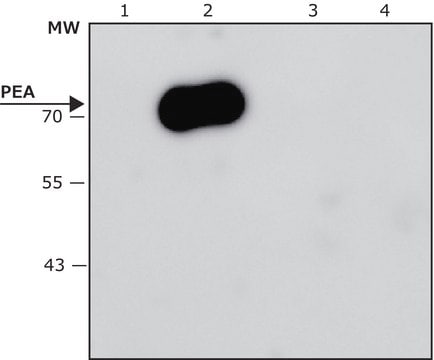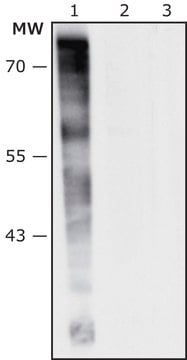P2318
Anti-Pseudomonas Exotoxin A antibody produced in rabbit
whole antiserum
Synonyme(s) :
Anti-ETA
Sélectionner une taille de conditionnement
343,00 €
Sélectionner une taille de conditionnement
About This Item
343,00 €
Produits recommandés
Source biologique
rabbit
Niveau de qualité
Conjugué
unconjugated
Forme d'anticorps
whole antiserum
Type de produit anticorps
primary antibodies
Clone
polyclonal
Contient
15 mM sodium azide
Espèces réactives
(Pseudomonas aeruginosa)
Technique(s)
dot blot: 1:20,000
indirect ELISA: 1:250,000
Conditions d'expédition
dry ice
Température de stockage
−20°C
Modification post-traductionnelle de la cible
unmodified
Informations sur le gène
Pseudomonas aeruginosa PAO1 ... toxA(877850)
Description générale
Immunogène
Application
- in the in vitro analysis of the stability of fusion toxins in serum[1]
- to construct an epidermal growth factor receptor (EGFR)-targeted toxin to study its toxicity on Swiss mouse embryo NIH-3T3 cells transfected with human EGFR
- in the determination of the in vivo half-life of immunotoxins in serum
Actions biochimiques/physiologiques
Forme physique
Stockage et stabilité
Clause de non-responsabilité
Vous ne trouvez pas le bon produit ?
Essayez notre Outil de sélection de produits.
Code de la classe de stockage
10 - Combustible liquids
Classe de danger pour l'eau (WGK)
nwg
Point d'éclair (°F)
Not applicable
Point d'éclair (°C)
Not applicable
Faites votre choix parmi les versions les plus récentes :
Certificats d'analyse (COA)
Vous ne trouvez pas la bonne version ?
Si vous avez besoin d'une version particulière, vous pouvez rechercher un certificat spécifique par le numéro de lot.
Déjà en possession de ce produit ?
Retrouvez la documentation relative aux produits que vous avez récemment achetés dans la Bibliothèque de documents.
Active Filters
Notre équipe de scientifiques dispose d'une expérience dans tous les secteurs de la recherche, notamment en sciences de la vie, science des matériaux, synthèse chimique, chromatographie, analyse et dans de nombreux autres domaines..
Contacter notre Service technique








